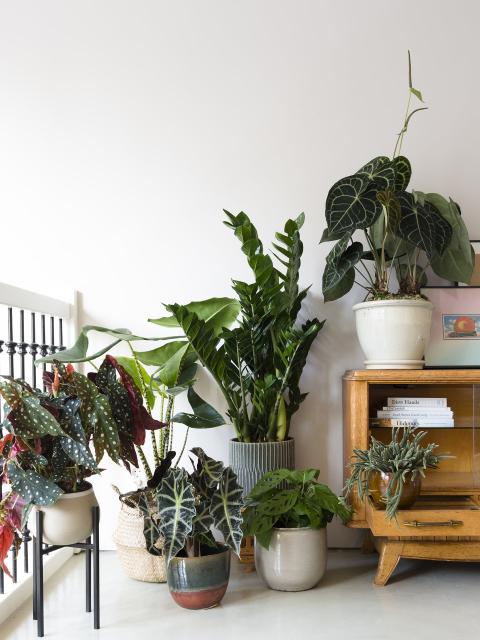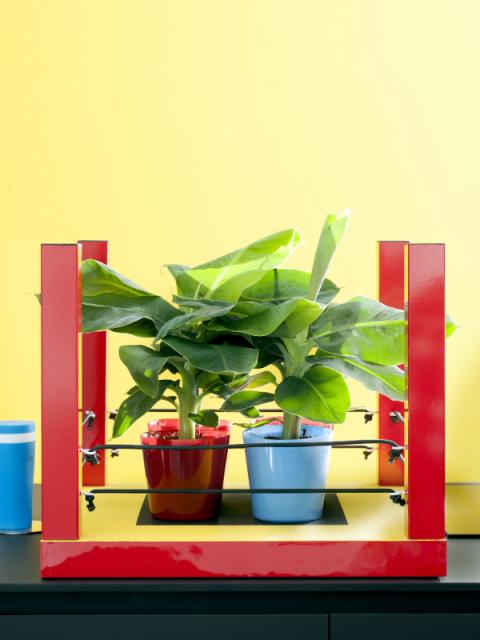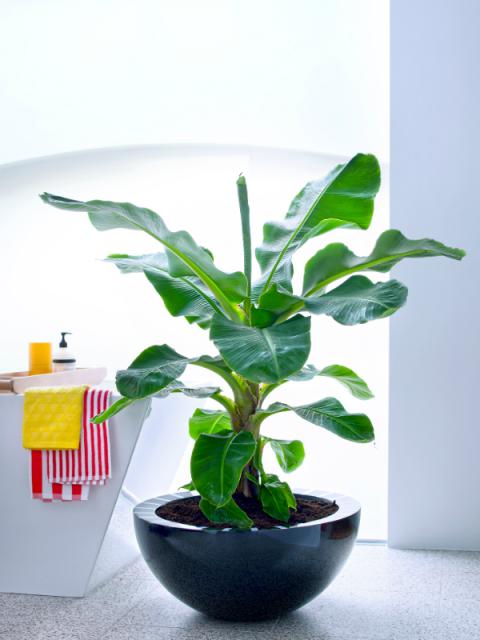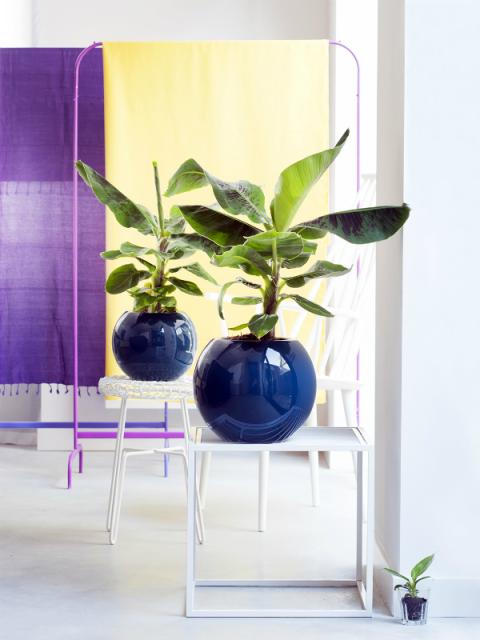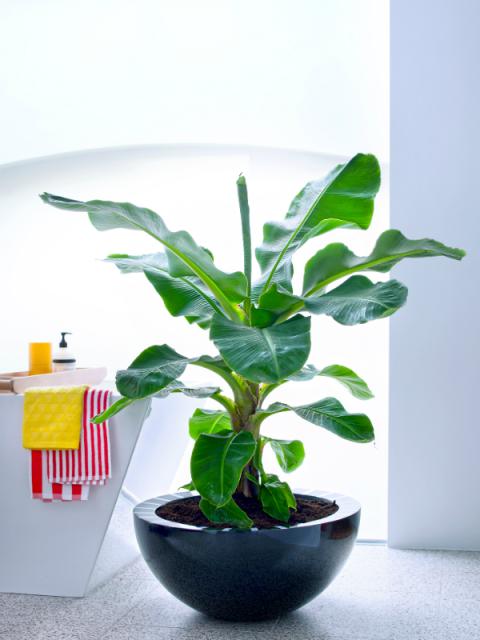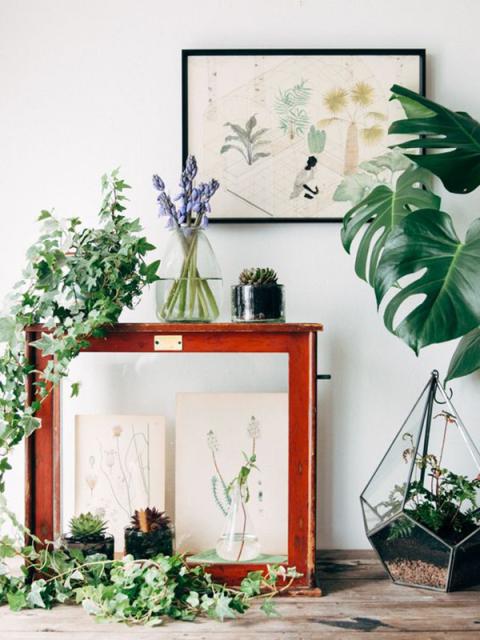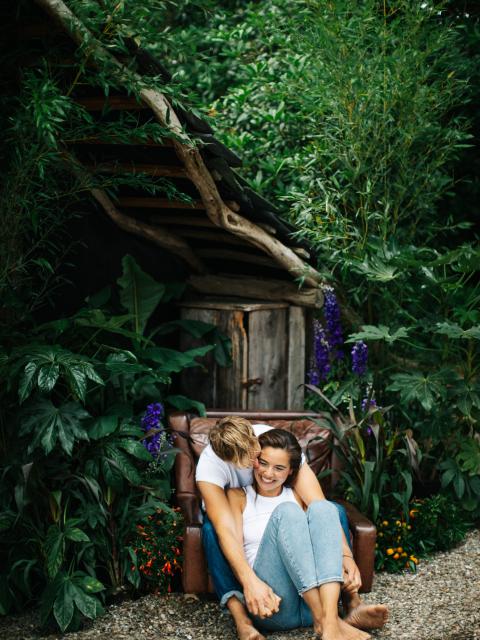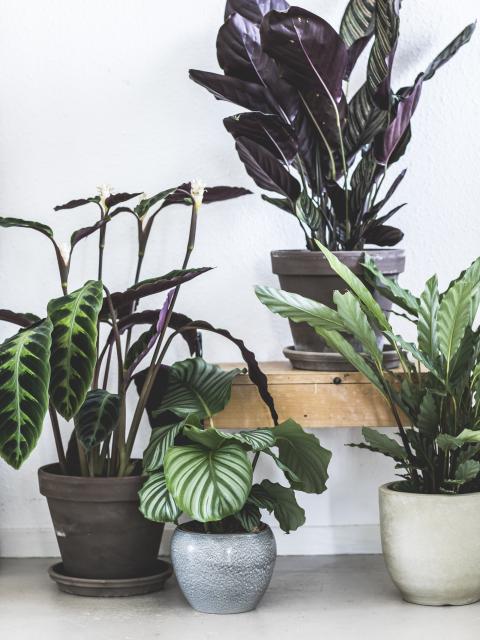Banana plant: characteristics and growth habits
The banana plant is often called the banana tree, because it has a sham trunk. New foliage is constantly pushed up from the centre, which then unfolds, resembling the trunk of a true tree. The Banana plant is a real eye-catcher with its large, dark green leaves and tropical look. This plant grows very quickly and regularly forms new shoots on its pseudo-stem. The plant's large leaves are thin and tear relatively quickly, but this doesn't detract from its appearance.
Banana plant belongs to the banana family (Musaceae) and is one of the most important fruit plants in the world. Originally from Southeast Asia and Australia, the plant is now grown in many tropical regions.
What types of banana plant are there?
There are around 400 species of banana plants worldwide. For edible bananas, the Cavendish is the most important species globally. In living rooms, you'll mainly see the Musa tropicana or Musa acuminata Dwarf Cavendish. These banana plants are small and managable enough to live indoors, growing up to a mere 2 metres tall. The best-known species of banana trees are:
- Musa acuminata: this is the botanical name of the species that includes most edible bananas, including Cavendish bananas. The plant produces clusters of edible bananas that are popular worldwide. The plant can grow about 6 metres tall in the wild. The leaves of the plant can be up to 3 metres long. The plant develops yellow or purple flowers that give way to bunches of bananas after flowering. Within this species, there are a number of compact cultivars (dwarf bananas) that are very popular as houseplants and for their edible bananas, namely:
- Musa Dwarf Cavendish: this plant has elongated leaves with light black spots and the is the most widely grown banana variety in the world, accounting for most of the global banana crop. The bananas grow in large bunches and are known for their sweet, mild flavour. Its compact growth (the plant grows 1.5-2 metres tall) also makes this variety very popular as a houseplant.
- Musa tropicana: this species has a smooth trunk and green hues in its glossy leaves. Tropicana grows about 2-3 metres tall and is also known as the ‘ice cream banana’ because of its creamy, sweet flavour reminiscent of vanilla and cream. Tropicana bananas are smaller than Cavendish bananas.
- Musa basjoo: this species is also known as the Japanese banana plant. The fruits aren't edible, and remain small and unripe. In the wild, this species can grow about 4 metres tall. The leaves are less shiny and more leathery than Musa acuminata. This species is hardy (down to -10°C) and can therefore grow in a wider variety of climates. In severe frosts, you'll need to cover the plant.
- Musa balbisiana: the fruits of this species are edible, but they have a tough skin and are less sweet than others. This species grows up to 3 metres tall and is characterised by bright green leaves with a rough texture.
- Musa ornata: this species, also called ornamental banana plant, has small, non-edible fruits that are mainly decorative, hence the name. The plant grows up to 2 metres tall and has narrow, green leaves.
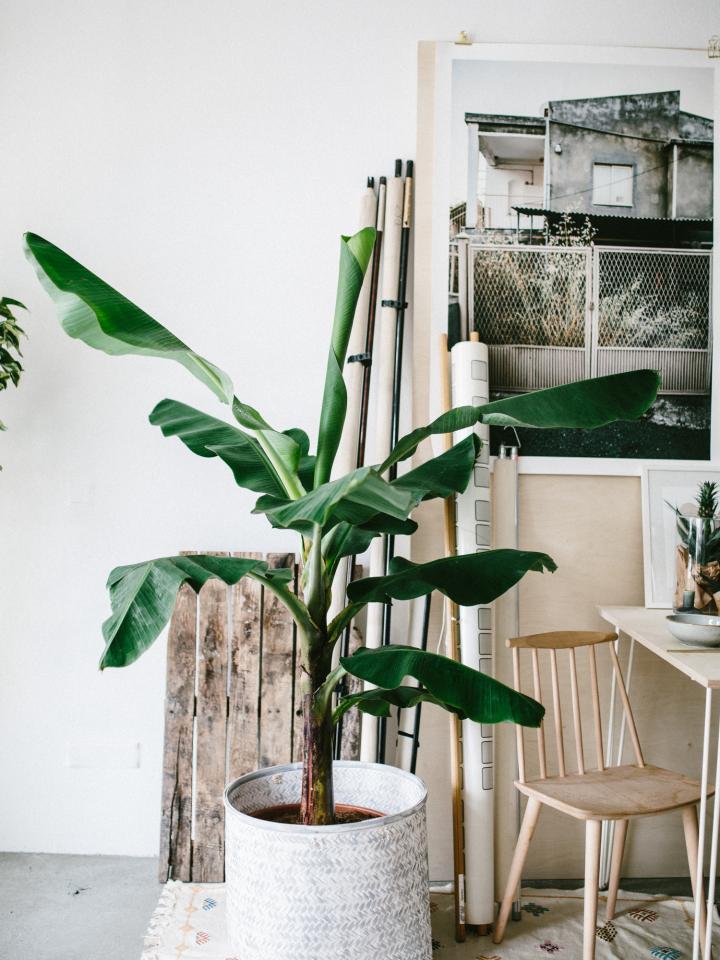
Banana plant: caretaking and location
Are you the proud owner of a new banana tree? You'll want to learn how to take care of it. Check out these basic rules and tips for caring for houseplants and see our advice below for the best location and caretaking of banana plants:
- Place your banana plant in a very light spot, but not in direct sunlight.
- Banana plants likes nice warm temperatures (at least 15 °C).
- Banana plants needs a lot of water. Make sure that the potting soil remains constantly moist. Water the banana tree when the top layer of the potting soil feels dry. In spring and summer (growing season), the plant needs more water than in winter. In summer, the plant may need daily watering! In winter, twice a week is usually sufficient.
- Banana plants originate from a tropical environment with high humidity. Therefore, you should spray the plant regularly with water.
- During the growing season (spring and summer), give banana plants plant food every few weeks.
- The leaves can break or snap easily, so handle with care.
- Is your banana plant getting too big? Remove some of the rootstocks to encourage it to develop fresh side shoots.
- Are the plant's lower leaves turning brown? Cut them off so that the plant retains its fresh, green colour.
What to do if your Banana plant has yellow or brown leaves
- Brown leaves on the underside of your banana plant: don't worry if the lower leaves get brown edges or turn brown. It's normal for the lower, older leaves to die off. Cut the brown leaves off the stem to keep the plant looking fresh.
- Brown leaves on top of your banana plant: are the top leaves turning brown? If so, it could be a sign that your banana plant isn't getting enough light or water. If so, change the location and/or watering habits. If you're concerned it's not getting enough sun, place the plant outside for a while during the hot, dry summer months.
- Yellow leaves on your banana plant: does your banana plant have yellow leaves? If so, it could mean it's getting too much light. Move it further away from nearby windows.

Will bananas grow on a banana plant in your home?
In the UK, banana plants are popular houseplants because of their large, decorative leaves and tropical look. The chances of growing edible bananas in your own home are very small, but it's not impossible. If this is your goal, you'll need to recreate the right climate for growth. You need lots of light and a warm, humid environment, achieved by placing the plant in a warm greenhouse or conservatory.
Note: it often takes more than three years for the first flowers to appear on the plant, and these are needed to produce fruit. Once the flowers have finished blooming, bananas can start growing, up to 25 centimetres in length.
How and when should you take Banana plant cuttings?
You can start taking cuttings from your Banana plants when you start seeing pups (offshoots) appearing. There are different ways to do this, but taking offshoot cuttings is the easiest way with the highest chance of success. It's best to take cuttings during the growing season (spring or summer), as this is when your plant is at its strongest and the cuttings will thrive the best. Take a look at our step-by-step plan below for taking banana plant cuttings.
Taking Banana plant cuttings: a step-by-step plan
Banana plant cuttings are best taken by means of offshoot cuttings (pup cuttings). If there aren't any offshoots growing get, be patient and consider giving the plant some extra food or repot it into a larger container to stimulate growth.
- Make sure the offshoot(s) are around 15-20 centimetres tall before you start taking cuttings. The bigger the offshoot, the greater the chance of success.
- Brush away a little soil to see if the offshoot already has roots. Is this is the case, dig out the area around the offshoot, or remove the mother plant completely from the pot and gently remove the potting soil.
- Carefully twist the offshoot loose from the mother plant. You can also cut it off with a sharp, clean knife. Cut it off vertically and as close to the mother plant as possible.
- Place the rooted cutting into its own pot with soil. Place the mother plant back into its pot and change the soil if necessary.
- Water both plants and place them in a light spot, but not in direct sunlight.
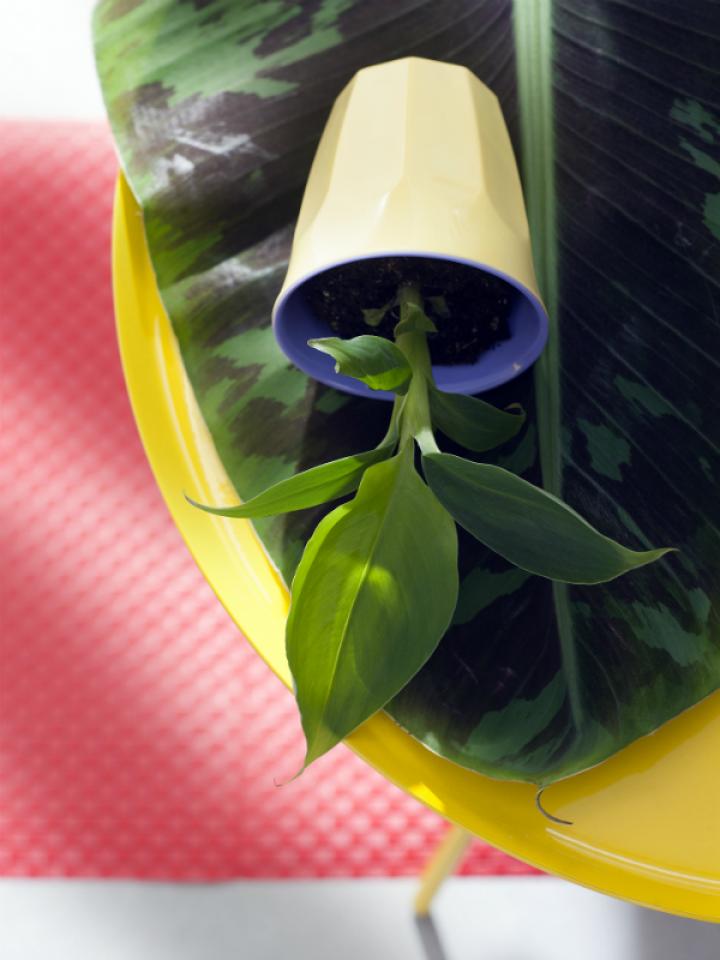
Why are bananas bent/crooked/curved?
Bananas owe their distinctive curved growth pattern to the dichotomy between negative geotropy and gravity. Bananas grow upwards, against gravity, which is called negative geotropy. As the banana bunches get heavier and heavier, they are pulled downwards by gravity, causing their curved shape.
Are Banana plants poisonous?
Banana trees are non-toxic to humans and domestic animals such as dogs and cats. This makes it a safe choice for families with young children or pet owners. The leaves of banana plant can cause digestive problems if consumed in very large quantities, so be aware of this.
Banana tree symbolism
The Banana plant has no single symbolic meaning, but several depending on culture and context. Here are the main symbolic meanings attributed to the Banana plant:
- Fertility and abundance: in many cultures, the Banana plant is associated with fertility and abundance. The plant owes this to the large quantity of fruit it produces, which is associated with prosperity and abundance.
- Wellness and health: bananas are highly nutritious. This makes the plant associated with healing, well-being and health in some cultures.
- Relaxation: banana plant grows in tropical climates and is associated with relaxation and calm.
Where do Banana trees originally come from?
The banana plant is native to tropical regions of Southeast Asia and Australia. It's one of the oldest cultivated crops - since the sixth century BC, according to Buddhist writings. From Southeast Asia, the banana plant spread to India through trade routes. In India, the banana was soon cultivated and spread to other parts of the world, such as the Middle East and Africa. In the 15th century, the banana plant came to Europe via explorers. Spanish explorers introduced the banana to the Canary Islands, where cultivation began.
An American engineer, Minor Keith, commercially launched banana production in Costa Rica around 1870. Improved transport methods such as railways and steamships allowed bananas to be brought to other countries more quickly, leading to an explosion in banana consumption.
Today, the banana plant is grown in many tropical countries. It's popular worldwide for its delicious fruit and decorative value.





